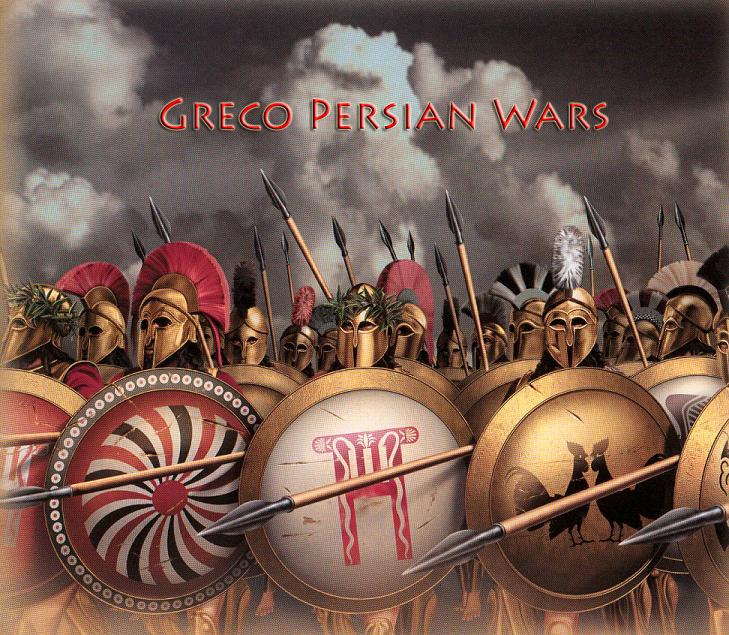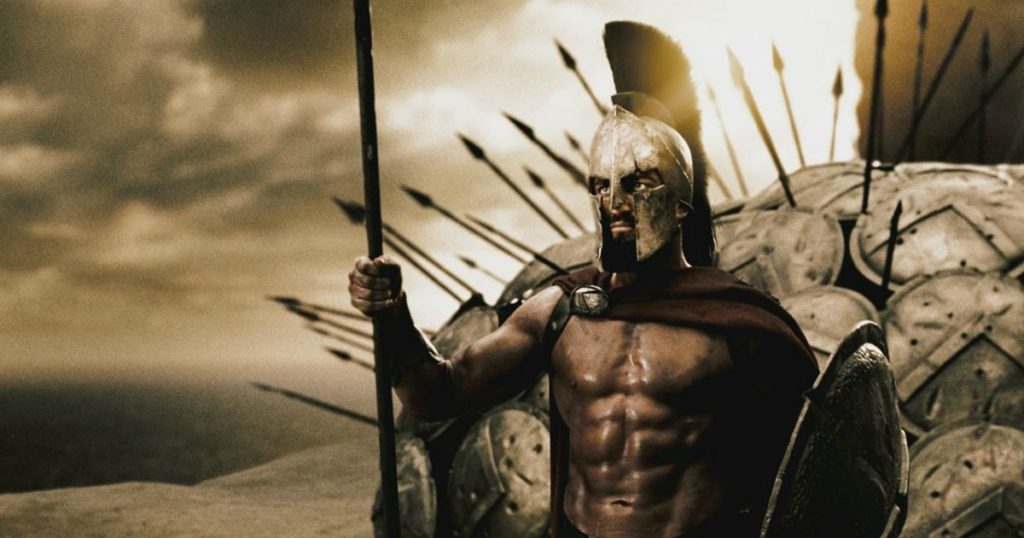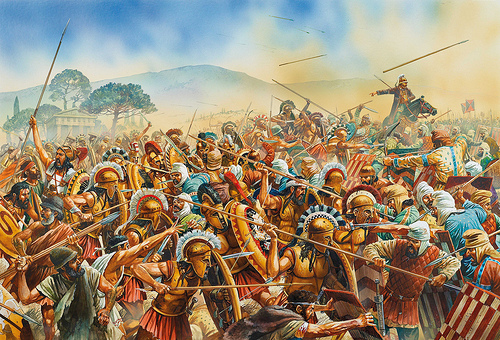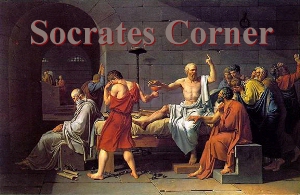Thermopylae—The Battle for the West vs. America: The Battle for Impeachment, Part II

“Against superior weaponry even the bravest [Persian Immortals] must fail, and when those better weapons were wielded by men [Spartans] whose whole life had been nothing but a preparation for war, the outcome was inevitable.”
~ Ernle Bradford
“It is not just that the human spirit reacts directly and beyond all arguments to a story of sacrifice and courage, as a wine glass must vibrate to the sound of a violin. It is also because, way back and at the hundredth remove, that company stood in the right line of history. A little of Leonidas lies in the fact that I can go where I like and write what I like. He contributed to set us free.”
~William Golding, essay The Hot Gates
In continuing my previous article, Thermopylae: The Battle for the West vs. America: The Battle for Impeachment, Part I, which covered the Books 1-13 of distinguished author and historian Ernle Bradford’s masterpiece, Thermopylae: The Battle For The West, Part II will now cover the remaining Books 14-25. In Part I, the primary preparations behind the Greco-Persian war were laid bare revealing key stratagems and decisions regarding the land and naval frontiers set by the Spartans, Athenians and Persians, who represented the leading factions of the war. The primary authors of the history behind the Greco-Persian War were Herodotus and Thucydides, the two most famous historiographers of Western civilization, as introduced in Part I. For further information regarding their work, visit my Father, Professor Ellis Washington’s article exploring the fascinating lietmotiv of “Fate” – an obsession of the Greeks.
Preparations for the war revealed the sheer size of the Persian army and fleet—which greatly outnumbered the allied Greek forces—in addition to the wide array of weapons and armor of which the Greeks often surpassed the Persians, battle maneuvers (most famously the Spartan phalanx), and the strategic decisions exercised by key Greek commanders such as Themistocles in the face of insurmountable odds. Following the first encounters between both sides, Part II now shifts into the actual warfare surrounding the most infamous and symbolic battle, Thermopylae. Fought between the 300 Spartans and 700 allied Thespians against the massive Persian army of 100,000-150,000 soldiers, Thermopylae was a valiant battle to the finish, and one representing the heroic final stand by King Leonidas against the persistent Persian land invasion. Beyond Thermopylae, I will also focus on many other famous encounters during the war of similar or equal importance, such as the Battle of Salamis (480 B.C.), and the Battle of Plataea (479 B.C.), emphasizing the most important elements of each skirmish.
Book 14: Battle
The Persian army’s march to Thermopylae had been delayed several days by the unexpected storm that caused significant damage to their fleet. Themistocles, General of the Greek naval forces, sought to attack the Persians before they could regroup and while they were working on repairs. In adhering to warnings by the natives to disobey a Spartan commander’s call for retreat, Themistocles was successful in bribing a few of the commanders to stay their ground in protecting the island of Euboea instead of withdrawing, most notably persuading Eurybiades, chief of the Spartan fleet. The Greek contingent at Artemesium advanced north toward the Persian fleet. As the Persian numbers built up, they attempted an encircling tactic known as periplous, designed to constrict the Greeks. But the well-trained Athenians planned ahead and orchestrated the kuklos, an outstanding defensive tactic which enabled the defensive circle of Athenian triremes to explode out into each direction, thereby striking the nearest enemy (similar to shrapnel exploding outward from a bomb). While Xerxes had promised a handsome reward to any Persian who should capture one of the famed Athenian vessels, not one of them was captured. Compared to the Athenians seizing 30 Persian vessels, taking prisoner many including the brother of the King of Salamis in Cyprus.
At night, the triumphant Greek ships withdrew, as Xerxes gave the order for his land forces to attack the Spartans at Thermopylae on August 18th 480 B.C. Xerxes gave the order for the Medes to attack first, likely due to their purported might or his vengeful view of their proud spirit (their rebellious nation having recently been conquered by the Persian empire). They bore dome shaped bronze/iron helmets, a jacket of fish-scale mail, tunic and trousers, while wielding short spears, daggers and bows. Bradford compared this to being woefully inadequate to the hoplite forces waiting at Thermopylae. Bradford confirmed that the massive Persian shower of arrows were indeed great enough to blot out the sun, prompting the famous Spartan phrase, “Good, then we shall fight in the shade.” But as voluminous as the volley of arrows were, they were no match in a closed range battle against the superior Greek long spear, the collective might of which Herodotus accustomed to a deadly porcupine. While their courage was great, man after man fell as the Medes were dismantled by the Spartan warriors, prompting their withdrawal. Following this, the men of Susa advanced in a wave toward the Spartans. The Greek piled bodies of fallen Persians as even those of Susa were unable to break their defensive line by neither close-ranged attack or arrow. By late afternoon, Xerxes determined that a breakthrough was needed at all costs, prompting him to order the advancement of his elite Persian guard: The Immortals.

Book 15: First Night and Second Day
While not as mighty as the Spartans, the Immortals represented the greatest most professional military caliber of the Persian Empire, led by the General Hydarnes. Under the watchful eye of their king, “they advanced to the attack, full of confidence that they would overcome the opposition without much trouble”, according to Persian accounts. While mighty and great they were, the Immortals soon shared the same painful lesson that the Medes and men of Susa had when their great numbers became a hindrance in the narrow pass of Thermopylae. They’re short spears were not formidable enough to penetrate the immovable wall of Greeks, nor their arrows enough to break the mighty Spartan bronze shields. Herodotus described how even the mightiest of the Immortals were outclassed by the superior weaponry and battle maneuvers of the Spartans, who had been bred for only war since early age. The Spartans would employ a tactical pretend retreat from battle to draw the advancing Immortals inward, only to reverse course and “inflict innumerable casualties upon them.” While the Spartans did lose a few men, the number of Persian dead were far greater. Watching atop his throne from a nearby area, Xerxes felt great dismay and frustration at the defeat of his forces, prompting those in his inner circle to fearfully hold their tongues.
The Spartans withdrew by nightfall, triumphant in their day of battle, yet preparatory for another day of continuous warfare tomorrow, in addition to the savage summer rainstorm that befell this night. The Persian contingent of ships circling around to the Euboea Channel were woefully caught off guard in another devastating attack from a Greek storm (see Book 13), causing many ships in open water to smash against the cove of sharp rocks. Employing the same hit and run tactic from the first storm, Themistocles and his fleet swiftly descended upon the battered Persian ships like a lightning bolt and destroyed the vulnerable Cilician fleet that night, retreating to Artemisum all before a major encounter could follow. Meanwhile, on the second day of battle, August 19th, Xerxes made lavish promises of great gifts to those who defeated the Spartans, while making threats of severe punishments to those who failed. Xerxes wrongfully assumed that the Spartans would be wearied and vulnerable from the previous day, as Herodotus notes that the Spartans often rotated men who were fresh to the battle to defend the front line against incoming Persians. As before the body count of the enemy stacked high before the immovable wall of bronze shields and spears. The morale among the Persian army was also so low, that they had to be driven forward by the crack of whips, causing a great confusion among the group being driven away from the Spartan wall of shields and those being whipped into advancing toward them.
In the midst of this defeat, Themistocles performed another lighting round of raids on the demoralized Persian fleet at sea. It was at this time that Xerxes would receive a turn of fate as he was confronted by the infamous Spartan traitor, Ephialtes (depicted as a deformed hunchback in the movie 300), appearing to reveal the direct secret to the Spartans’ rear path through the mountain of Kallidromos. Ephialtes would not only inform them on how to navigate the secret route east of the main pathway, but he would act as a personal guide. Xerxes made haste to assemble General Hydarnes and a group of the ten thousand Immortals to hike through the rough Greek mountains (a mountainous terrain similar to what they themselves were accustomed to), seeking revenge on the Spartans for their demoralizing defeats.
Book 16: Over the Mountain
Led by Ephialtes, General Hydarnes and the Immortals marched up the longer, more difficult route of the Kallidromos mountain under the guise of nightfall. Only the more poorly trained citizen army of the Greek Phocians were encamped to guard the hidden pass, placed there by Leonidas. They were taken completely by surprise by the incoming Persians, sleeping with no armor, guard posts or any other preparation measures. Bradford laments that the 1000 Phocian soldiers performed in the most cowardly and incompetent manner, fleeing their narrow post to a nearby peak at the sight of incoming arrow attack by the Immortals. Word of this had already reached Leonidas, who suspected that all would soon be lost. Many historians report that Leonidas allowed many of the allied Greek forces at Thermopylae to return to their respective states in order to spare their lives, while every Spartan remained to defend the pass. Most likely 2000 out of the original 2300 troops stayed their ground at Thermopylae. As the men found time to comb their hair, Leonidas gazed at them with a commanding soulful demeanor, stating, “Have a good breakfast, men, for we dine in Hades!”
Book 17: End and Beginning
The next morning, Xerxes celebrated the rising of the sun, who Persians viewed as the god “Ahuramazda”, awaiting General Hydarnes and the Immortals to make voyage around the hidden goat path within a few hours. It is here that Bradford not only admires the Spartan bravery, beaten into every Spartan adherent to the strict law of Lycurgus, where sacrifice for one’s own country was how a “man was made”, but also admires the few brave Thespians and Thebans that opted to remain to the bitter end as well. Leonidas decided to change his tactics and inflict the greatest level of damage to the enemy before he and his forces were killed. He moved a group of Spartans from the narrowest part of the path, forward to the part that broadened. As described by Herodotus, the first invasion began, with many of the Persians falling as the group of commanders viciously whipped them into attacking, from behind. Many of the invaders were trampled by other incoming soldiers and knocked off the edges of the cliff into the sea where many drowned. The relentless onslaught of Persian soldiers clashing with Greek spears eventually caused many to break, prompting the Spartans to withdraw their sword and attack the enemy up close. Amid this part of the action, Leonidas was slain in battle, “having fought most gallantly”, according to Herodotus. Thus, a violent battle ensued over control of Leonidas’s body, as the Persians desired to seize a valuable trophy, while the Spartans determined to deny them this victory. The Greek forces eventually drove the enemy back after four major encounters, dragging Leonidas’s body back into their camp, and after killing many Persians in the process, including two of Xerxes’s own brothers. It is shortly after this that General Hydarnes and the Immortals outflank them from the hidden goat’s path, with the cry of the sentry yelling, “Here they come!”

It is here that Herodotus depicts the Spartans drawing back into the narrow portion of the pass, forming themselves into the compact phalanx defense, with the exception of the Thebans. “In this place they defended themselves to the last, with their swords, if they still had them, and if not, even with their hands and teeth”, Herodotus wrote. As Spartan after Spartan fell, they often resorted in throwing whatever was at their disposal, including swords, arrows, javelins and even rocks, prompting many Persians to keep their distance from these tenacious men. Many Spartans were given just praise for their heroism in battle, including Diceneces (notable for his remark about “fighting in the shade” of Persian arrows blotting out the sun). The Thespians, similar to the Spartans, died man to man. By midday, the legendary battle of Thermopylae had transpired, allowing Xerxes to scour the battlefield, amazed by the incredibly large number of dead Persians lay before him. Xerxes ordered his legions of fallen soldiers to be buried so as not to steal the morale from the incoming Persian hordes, withholding the testament as to what only a handful of Spartans and allied Greeks could achieve. Xerxes had Leonidas beheaded and displayed on a pike, most likely as a sign that the seemingly unbeatable Greeks were mere men…. At the same time, the Persian strategy was to work in concert with their 450-ship fleet at sea, and the order was given at Artemisium to launch a counter-attack against the 300 Greek triremes. As the battle at sea ensued, the Greeks held an advantage of solidity to the Persians in terms of armor and ship strength, only matched somewhat by the heavily armored Egyptian marines. The enemy managed to capture 5 Greek triremes, and served a major blow to the Greeks at sea. Nevertheless, the battle at Artemisium ended in a stalemate while concurrently working against the high hopes Xerxes had for victory. While collecting the dead and salvaging materials, the Greeks found that the people of Euboea had abandoned many of their sheep upon evacuating the shore of their island, prompting Themistocles to order their capture for food. Wreckage was burned and fire for funeral pyres set. With Thermopylae lost, Artemisum to the north was indefensible, putting an end to Themistocles’s strategy of the concerted land-sea defensive barrier.
Book 18: After Thermopylae
After the war concluded, the Anphyctionic League set up a memorable plaque to honor the brave sacrifice of the 300 Spartans and allied Greeks at Thermopylae. A commemorative memorial with the names (Roll of Honour) of all 300 Spartans was erected at Sparta, in addition to a large statue of King Leonidas. Xerxes debated taking the advice of his Greek envoy Demaratus, who encouraged him to divide his fleet at sea, keeping a portion of them at Artemesium, while sending a contingent of them southward to engage other Greek forces. But a hesitant Xerxes rejected this advice at the behest of his brother Achaemenes, who reminded him of all the calamity from the storms at Euboea and the aggressive tactics of Themistocles, “whose hard-fought battle of Artemisium, now paid dividends.” Xerxes was in no hurry, taking an entire day at Thermopylae to bury the 20,000 dead, according to Herodotus. He left only a thousand Persians unburied and all the Greeks in place to allow his fleet “to see what the King does to the madmen who thought they could oppose him”, according to Xerxes, in his attempt to propagandize the horrors of losing so many in proportion to the Greeks. The Persian army then began its march southward to central Greece.
Book 19: In Another Country…
While Xerxes marched southward during the summer of 480 B.C., his forces coordinated with the Carthaginians lead by General Hamilcar attacked Sicily with a 200,000-man army and equally formidable infantry. Similar to the Sicilian Greeks, Carthage relied heavily on cavalry and chariots in battle, which held a good advantage even against hoplites. But much to their disadvantage, the maestro or “master wind” blew hard from the north,scattering and sinking many of the Carthaginian ships, leaving Hamilcar in a more terrible situation than Xerxes. For Hamilcar, to eliminate a great threat to Carthaginian colonies and move east, taking over Greek cities one by one was the long-term strategy. Also driving him was the desire for the rich abundance of minerals, grain and rare commodities found on the island of Sicily. Xerxes’s desire to conquer not only Athens and Sparta, but the entire Mediterranean, is a great ambition that would rival Alexander the Great’s the former seemed more achievable in the annals of the history of warfare. Because of his naval woes, General Hamilcar was forced to move his forces completely to land where he sent his troops to attack the western wall around Himera. But a Greek cavalry of 5,000 swiftly cut through Hamilcar’s western flank in his defenses, killing hundreds in the process. Furthermore, Hamilcar had lost many of his reliable cavalry in sunken transports, forcing his soldiers to fight on foot; something they were somewhat unfamiliar with.
The Greeks miraculously prevented any message from Hamilcar regarding calvary reinforcements from getting out of his camp, as his foe, Gelon of Syracuse, set up camp in the east bank of the River Himeras opposite of the city so as to avoid being outflanked by attacks from the west. Gelon decided to unleash an attack on Hamilcar’s forces at the same time that his ally Theron led his forces out of the walls of Himera to also assault Hamilcar. The two-prong attack worked wonderfully, and as both sides decimated Hamilcar’s forces, Hamilcar himself was caught completely unaware, having dressed in priestly robes to offer a sacrifice to Poseidon for victory. He was killed and cast into the sea next to those he recently slaughtered. Carthage was forced to give 2000 talents as ransom to ensure that Gelon wouldn’t order an assault on Carthage by sea after his triumphant victory. The Battle of Himeras (likely to have taken place on the same day that Leonidas and his men gave their last defense at the Hot Gates) was viewed as a glorious victory that rivaled even the success of Salamis, warding off an African threat to Sicily and other Western nations for many years to come.
*N.B: This essay is based in part on Ernle Bradford’s book, Thermopylae: The Battle for the West, republished by De Capo Press in 1980, and Great Books of the Western World, Vol. 6: Herodotus—Thucydides, edited by Robert Maynard Hutchins (Encyclopedia Britannica, 1952), On Fate, examining the works by Herodotus and Thucydides; Ellis Washington, The Progressive Revolution, Vol. 5 (2017), pp. 153-56.
*To be continued in Part III, which will summarize the series and fully incorporate and compare the elements of the Greco-Persian Wars to the political war that rattled America in the historic impeachment trial of President Donald Trump.
Category: Socrates Corner






